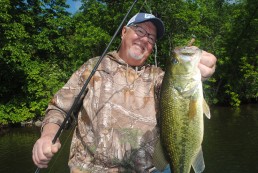Stressed-Out Fish
SHARE THIS POST
Bob Jensen shares some suggestions for catching fish that are stressed out by fishing pressure.
I wish that fish responded to stress the way that some people do. Some people, when in a stressful situation, eat more than usual. Fish usually respond to stress by eating less. A lot less. Fishing pressure often causes stress for fish. Here are some ideas on how to catch fish that are stressed due to fishing pressure.
The definition of fishing pressure changes from region to region. In some places, anglers can be on the water every day of the year. That creates a lot of fishing pressure. In places where ice forms on lakes, the fish get a break between open water fishing and ice fishing. The fish still get fishing pressure; just not as much as they do in other places.
Another thing about fishing pressure: Large bodies of water might have more people fishing that body of water, but there are more spots to fish. A smaller body of water might only have a few boats on it, but there are also fewer spots to fish. The good fishing locations on the large lake might only get hit once or twice a day, but the best fishing spots on smaller lakes could be visited by anglers several times a day.
Fishing pressure is real, and it often causes fish to get lure-shy. In the early 1980s, I was an instructor at a fishing school in Walker, Minn. called Camp Fish. Camp Fish was located on a chain of small lakes full of largemouth bass. Due to economics and safety, we used mostly jigworms to catch those bass. We would start the fishing season using 1/8-ounce jigs and 4-inch blue worms—what we had the most of. Every weed line on those lakes got pounded.
For the first couple of weeks of the season, those 4-inch blue worms caught a lot of fish. As the season progressed, the blue worms lost their effectiveness. We went to worms of different colors and started catching bass again. The lessons learned then are what I apply now when the fish are pressured.
Today, when bass are getting pressured and don’t want to bite, that jigworm still comes into play. Jig-plastic might be a better way to describe it. We’ll get on a weedline and start with a 3/16-ounce jig head and an Ocho Worm. These worms catch bass almost anywhere, almost anytime. But sometimes we need to adjust the speed at which the jig is falling. We might be better off with a 1/8-ounce, maybe even a 1/16-ounce head. These fall a bit slower and might appeal to the bass better.
Are you enjoying this post?
You can be among the first to get the latest info on where to go, what to use and how to use it!
Six- or 8-pound-test line is usually a good choice, but sometimes, we’ll use heavier line. The heavier line has more water resistance and slows the jig’s fall even more. Not a lot, but sometimes enough to make a difference. Or we’ll substitute the worm with a plastic like a Rage Craw. These baits are bulkier and have appendages that slow the fall speed. Small details are often difference makers.
Walleye ace Drake Herd slows down for pressured walleyes. In spring, when the walleyes are spawning, they’ll be shallow, and that’s where most anglers will be also. The walleyes sense boats overhead and see anchors splashing and dragging along the bottom. They see the feet and legs of wading anglers. The walleyes become more cautious and less willing to eat.
At this time of year, Drake works very slowly, usually with a jig and minnow combination. Sometimes, he rigs it under a slip-bobber. Every now and then, just to give a different look, he’ll slowly crawl the smallest Rage Swimmer across the bottom. Drake catches walleyes when other anglers don’t.
Keep these ideas in mind when you’re after fish that don’t want to bite because of fishing pressure, and you’ll increase your odds for fishing success.
For insight on how to catch fish in any climate, check out the articles in every issue of MidWest Outdoors. Subscribe on our website.
Did you enjoy this post?
You can be among the first to get the latest info on where to go, what to use and how to use it!
Bob Jensen
To see the latest episodes of “Fishing the Midwest” television, new fishing-related tips and articles from the past, visit fishingthemidwest.com. Follow them on Facebook @fishingthemidwest for fishing information and entertainment.

